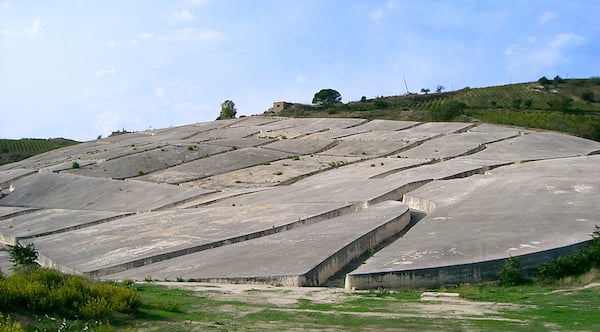
Photo: via Spot U Art
Alberto Burri’s land art masterpiece, Grande Cretto, which was 30 years in the making, was finally opened to the public in Sicily this past Saturday.
The project’s completion coincides with the artist’s 100th anniversary and arrives at a moment when Burri’s market is experiencing a massive resurgence, accompanied by a string of solo shows—from a major retrospective, “Alberto Burri: The Trauma of Painting” at the Solomon R. Guggenheim Museum in New York, to gallery shows in key cities, including Luxembourg & Dayan in New York and Mazzoleni Art in London—as well as phenomenal performances at auction.
Alberto Burri Rosso Platica (1963)
Photo: Art Market Monitor
Grande Cretto is a sprawling concrete landscape of 8,000 square meters which was conceived by the artist in 1981 as a memorial to the town of Gibellina in Sicily, which was flattened by a magnitude 6.1 earthquake in 1968. The city could not be rebuilt on the same grounds after the tragedy struck.
The then mayor of the city, Ludovico Corrao, invited a group of artists to present proposals for New Gibellina, which was rebuilt 20 kilometers away. Most artists presented projects for buildings, squares, and public sculpture, but Burri, ever the maverick thinker, decided to work on the ruins of the old town instead, according to Archiportale.
Alberto Burri.
Photo: via Eliconie
Burri covered the ruins with large blocks of white concrete, featuring hundreds of cracks in between them and on their surfaces, which by then had become a signature motif in his oeuvre (Burri has a number of works titled with the word “cretto,” crack in Italian). The concrete slabs measure 10 to 20 meters on each side, and are about 1,60 meters tall, so the scale of the piece is absolutely monumental.
The construction of the vast work began in earnest in 1985, and it was halted in 1989, when about 6,000 square meters had been covered. But 2015 marks the 100th anniversary of the renowned artist and to commemorate the date, the Fondazione Burri decided to finish the epic work.
Alberto Burri’s Grande Cretto, in Sicily.
Photo: via Palinsesti
As part of the events program for the public launch of the work on Saturday, the Grande Cretto became the stage of AUDIOGHOST 68, for which musician and member of Massive Attack, Robert Del Naja, and artist Giancarlo Neri created a light-and-sound installation, featuring hundreds of portable radios scattered across the Cretto and involving the participation of the audience.
“Alberto Burri’s Grande Cretto, remembering but also hiding the tragic event under concrete, represents a return to life through art,” Del Naja and Neri said in a statement. “We would like to pay homage to this great piece, and to the great artist who created it, with a ‘collective’ work that would further underscore its greatness.”
This is not the only large-scale installation by Burri that has been revamped to commemorate the artist’s centenary. Teatro Continuo, a public sculpture that Burri offered to Milan in the early 1970s and which was subsequently demolished, was also rebuilt and launched in May, and activated with a public program of performances and activities.
Dancer’s using Alberto Burri’s Teatro Continuo before its demolition in 1989.
Photo via: La Repubblica